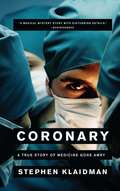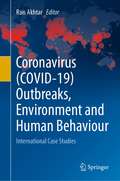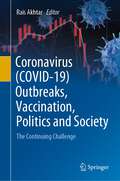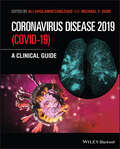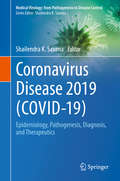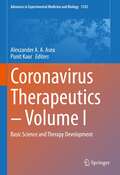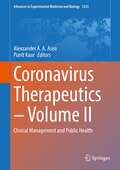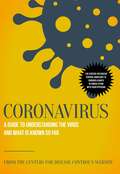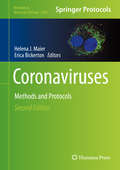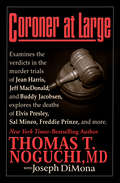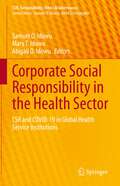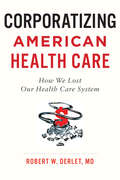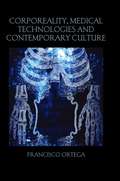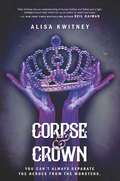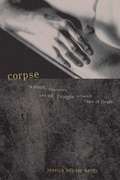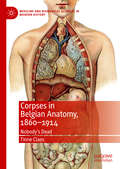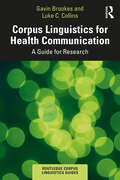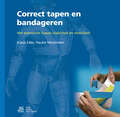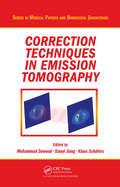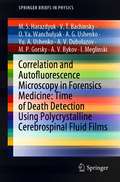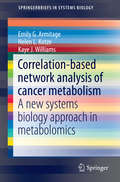- Table View
- List View
Coronary: A True Story of Medicine Gone Awry
by Stephen KlaidmanA chilling real-life medical thriller, Coronary chronicles the story of two highly respected heart doctors who violated the most sacred principle of their profession: First, do no harm. In the summer of 2002, fifty-five-year-old John Corapi, a Catholic priest with a colorful background, visited Dr. Chae Hyun Moon, a celebrated cardiologist in Redding, California. Corapi had been suffering from exhaustion and shortness of breath, and although a physical examination and a conventional stress test revealed nothing abnormal, Moon insisted that the calcium level in Corapi's coronary arteries called for a highly invasive diagnostic test: an angiogram. A chain-smoking Korean immigrant known for his gruff bedside manner, Moon performed the procedure briskly and immediately handed down a devastating diagnosis: "I'm sorry; there is nothing I can do for you. You need a triple bypass tomorrow morning." He then abruptly left the room. Several hours later, however, Moon inexplicably decided the surgery could wait until Corapi returned from a previously scheduled cross-country trip. Unnerved by the dire diagnosis and also by Moon's inconsistent statements, Corapi sought other opinions. To his amazement, a second, third, and fourth doctor found that his heart was perfectly healthy. In fact, for a man his age, Corapi's arteries were remarkably free of disease. Sensing a cause more disturbing than human error, Corapi took his story to the FBI. As local agent Mike Skeen soon discovered, Corapi was one of a number of people who had suspicions about Moon and Moon's go-to cardiac surgeon, Dr. Fidel Realyvasquez, an equally respected member of the close-knit northern California community. Working at a hospital owned by Tenet Healthcare, Moon would make the diagnoses and Realyvasquez would perform the surgeries. Together, these leaders of the Redding medical establishment put hundreds of healthy people at risk, some of whom never recovered. Soon Skeen launched a major investigation, interviewing numerous doctors and patients, and forty federal agents raided the hospital where the doctors worked.A timely and provocative dissection of America's medical-industrial complex, Coronary lays bare the financial structures that drive the American healthcare system, and which precipitated Moon's and Realyvasquez's actions. In a scheme that placed the demands of Wall Street above the lives of its patients, Tenet Healthcare rewarded doctors based on how much revenue they generated for the corporation. A meticulous three-year FBI investigation and hundreds of civil suits culminated in no criminal charges but a series of settlements with Tenet Healthcare and the doctors that totaled more than $450 million and likely put an end to Moon's and Realyvasquez's medical careers. The case's every twist and turn is documented here. A riveting, character-rich narrative and a masterpiece of long-form journalism, Coronary is as powerful as it is alarming. This is a hair-raising story of the hundreds of men and women who went under the knife, not in the name of medicine, but of profit and prestige. Brilliantly told, Stephen Klaidman's Coronary is a cautionary tale in the age of miracle medicine, and a shocking reminder to always get a second opinion.
Coronavirus (COVID-19) Outbreaks, Environment and Human Behaviour: International Case Studies
by Rais AkhtarThis book covers over 24 country studies on various dimensions associated with the geographical spread of COVID-19. The chapters in the book, from geographically diversified countries, assert the need to undertake intensive regional research in order to understand the global pattern of Coronavirus focusing on infection migration, and indigenous origin that has caused tremendous global economic, social and health disaster. The book contends that understanding of peoples’ behaviour is crucial towards safety measures against infection, as COVID-19 impacted to a greater extent social wellbeing of population because of lockdowns in all corners of the world.Some of the countries featured are USA, France, Italy, Hong Kong, South Korea, Canada, Australia, Pacific Islands, Russia, Taiwan, Thailand, Malaysia, Indonesia, India, South Africa, Nigeria, Mexico, Peru and Brazil.
Coronavirus (COVID-19) Outbreaks, Vaccination, Politics and Society: The Continuing Challenge
by Rais AkhtarThis books comprises of 24 chapters by experts from developed and developing countries. The book cover Argentina, Australia, Bangladesh, Brazil, Canada, Fiji, France, India, Indonesia, Italy, Japan, Malaysia, Mexico, Papua New Guinea, South Africa, Taiwan, Thailand, the UK and England, USA, West Africa, and Zambia.FOREWORD by David J. Hunter, Emeritus Professor, Newcastle University, the UK.
Coronavirus - COVID-19
by Hesperian Health GuidesCOVID-19 is a disease caused by a coronavirus, which is a small germ (too small to see without a microscope), that can spread between people. Hesperian Health Guide's COVID-19 fact sheet helps clearly answer the following important questions: What is COVID-19? How does the coronavirus spread? Who does coronavirus infect? How can you prevent infection?
Coronavirus Disease - COVID-19 (Advances in Experimental Medicine and Biology #1318)
by Nima RezaeiIn December 2019, the world witnessed the occurrence of a new coronavirus to humanity. The disease spread quickly and became known as a pandemic globally, affecting both society and the health care system, both the elderly and young groups of people, and both the men’s and women’s groups. It was a universal challenge that immediately caused a surge in scientific research. Be a part of a world rising in fighting against the pandemic, the Coronavirus Disease - COVID-19 was depicted in the early days of the pandemic, but updated by more than 200 scientists and clinicians to include many facets of this new infectious pandemic, including i, characteristics, ecology, and evolution of coronaviruses; ii, epidemiology, genetics, and pathogenesis (immune responses and oxidative stress) of the disease; iii, diagnosis, prognosis, and clinical manifestations of the disease in pediatrics, geriatrics, pregnant women, and neonates; iv, challenges of co-occurring the disease with tropical infections, cardiovascular diseases, hypertension, and cancer and to the settings of dentistry, hematology, ophthalmology, and pharmacy; v, transmission, prevention, and potential treatments, ranging from supportive ventilator support and nutrition therapy to potential virus- and host-based therapies, immune-based therapies, photobiomodulation, antiviral photodynamic therapy, and vaccines; vi, the resulting consequences on social lives, mental health, education, tourism industry and economy; and vii, multimodal approaches to solve the problem by bioinformatic methods, innovation and ingenuity, globalization, social and scientific networking, interdisciplinary approaches, and art integration. We are approaching December 2020 and the still presence of COVID-19, asking us to call it COVID (without 19).
Coronavirus Disease 2019 (Covid-19): A Clinical Guide
by Ali Gholamrezanezhad Michael P. DubeCORONAVIRUS DISEASE 2019 (COVID-19) CORONAVIRUS DISEASE 2019 (COVID-19) Provides comprehensive coverage of all key aspects of COVID-19, including: etiology, diagnosis, symptomatology, management, and treatment Coronavirus Disease 2019 (COVID-19): A Clinical Guide provides healthcare professionals at all levels with up-to-date knowledge about the clinical, epidemiological, genomic, virological, and radiologic features of COVID-19. Consolidating multiple systematic reviews and meta-analyses into a single volume, this comprehensive textbook also addresses health policies, mass casualty planning, healthcare worker safety, economic impact, lessons for future outbreaks, and other para-clinical and social aspects of the COVID-19 pandemic. The text presents a thorough summary and critical analysis of COVID-19 based on an exhaustive review of recently published literature and data. Topics include the virologic characteristics of SARS-CoV-2, pulmonary and extrapulmonary manifestations and consequences of COVID-19, prevention and transmission control, the pandemic’s indirect impact to the care and management of other diseases, passive immunotherapy and its implications, diagnostic and treatment approaches for critically ill patients, and more. Edited by leading practitioners at the forefront of COVID-19 research, this invaluable resource: Integrates clinical, radiological, and epidemiological data and discussion of prevention, diagnosis, and treatment Reviews the epidemiology, mechanisms of action, manifestations, and management of cardiovascular, neurological, and pulmonary diseases associated with COVID-19 Covers diagnostic technologies, includes radiologic imaging, and RT-PCR testing Explores therapeutic approaches for managing a variety of complications Discusses post-vaccination symptom management and implications of immunization Addresses COVID-19 in pediatrics, in cancer patients, and in patients with lung disease, diabetes, hypertension, obesity, and other underlying conditions Coronavirus Disease 2019 (COVID-19): A Clinical Guide is an indispensable source of information for all clinicians, researchers, epidemiologists, nurses, radiologists, and healthcare managers working to address any aspect of the COVID-19 pandemic.
Coronavirus Disease 2019: Epidemiology, Pathogenesis, Diagnosis, and Therapeutics (Medical Virology: From Pathogenesis to Disease Control)
by Shailendra K. SaxenaThis book provides a comprehensive overview of recent novel coronavirus (SARS-CoV-2) infection, their biology and associated challenges for their treatment and prevention of novel Coronavirus Disease 2019 (COVID-19). Discussing various aspects of COVID-19 infection, including global epidemiology, genome organization, immunopathogenesis, transmission cycle, diagnosis, treatment, prevention, and control strategies, it highlights host-pathogen interactions, host immune response, and pathogen immune invasion strategies toward developing an immune intervention or preventive vaccine for COVID-19. An understanding of the topics covered in the book is imperative in the context of designing strategies to protect the human race from further losses and harm due to SARS-CoV-2 infection causing COVID-19.
Coronavirus Therapeutics – Volume I: Basic Science and Therapy Development (Advances in Experimental Medicine and Biology #1352)
by Alexzander A. A. Asea Punit KaurThe book Coronavirus Therapeutics Volume I provides the most comprehensive review on contemporary knowledge on the origin and structural biology and molecular aspects of Coronaviruses. This also describes the etiology and pathogeny and therapeutic targets including vaccine drug candidates against Coronaviruses in the light of current scientific knowledge. Using an integrative approach to the understanding of Coronaviruses structure, function and immunobiology, the contributors provide a synopsis of novel mechanisms by which Coronaviruses can be treated.Key basic and clinical research laboratories from major universities, academic medical hospitals, biotechnology and pharmaceutical laboratories around the world have contributed articles that review present research activity on the role of heat shock proteins in human diseases and importantly project the field into the future. The book is a must read for graduate students. medical students, basic science researchers and postdoctoral scholars in the fields of Cancer Biology, Oncology, Cardiovascular Diseases, Microbiology, Inflammation, Translational Medicine, Clinical Research, Biotechnology, Cell & Molecular Medicine, Pharmaceutical Scientists and Researchers involved in Drug Discovery.
Coronavirus Therapeutics – Volume II: Clinical Management and Public Health (Advances in Experimental Medicine and Biology #1353)
by Alexzander A. A. Asea Punit KaurThe book Coronavirus Therapeutics Volume II provides the most comprehensive review on contemporary knowledge on the consequences during the outbreak of Coronavirus. This also describes the clinical features, diagnostic evaluation and management of Coronavirus patients. Using an integrative approach to the understanding of paradigm gap in host-pathogen interaction studies to the management of Coronavirus patients in the Intensive Care Unit to the current challenges for the effective management of Coronavirus pandemic risk factors including diabetes, hypertension, obesity and repercussion on the central and peripheral nervous system.Key basic and clinical research laboratories from major universities, academic medical hospitals, biotechnology and pharmaceutical laboratories around the world have contributed articles that review present research activity on the role of heat shock proteins in human diseases and importantly project the field into the future. The book is a must read for graduate students. medical students, basic science researchers and postdoctoral scholars in the fields of Cancer Biology, Oncology, Cardiovascular Diseases, Microbiology, Inflammation, Translational Medicine, Clinical Research, Biotechnology, Cell & Molecular Medicine, Pharmaceutical Scientists and Researchers involved in Drug Discovery.
Coronavirus: A Guide to Understanding the Virus and What is Known So Far
by The Centers for Disease Control's WebsiteThe novel coronavirus that causes COVID-19 is now officially a global pandemic with over 130,000 confirmed cases and over 5,000 deaths. Its path is exponential, and panic is being felt around the globe. But the most important thing you can do to combat the virus is to understand how it works, how it spreads, and to STAY INFORMED. What Does This Coronavirus Outbreak Guide Contain? In-depth history of the virus since its inception Scientific explanation of what coronavirus is and how it works Actionable advice on how to stop the novel coronavirus from spreading Specific tips for employers, employers, and those who must travel during the outbreak Updated statistics on symptoms, treatment, and global survival rates. This 2019-2020 Coronavirus Outbreak Guide is from the CDC Website. Learn the truth about how this virus works. And whatever you do, don&’t forget to wash your hands.
Coronaviruses: Methods and Protocols (Methods in Molecular Biology #2203)
by Erica Bickerton Helena J. MaierThis detailed new edition provides a comprehensive collection of protocols applicable to all members of the Coronavirinae sub-family currently and that are also transferrable to other fields of virology. Beginning with a section on detection, discovery, and evolution, the volume continues with coverage of propagation and titration of coronaviruses, genome manipulation, study of virus-host interactions, as well as imaging coronavirus infections. Written for the highly successful Methods in Molecular Biology series, chapters include introductions to their respective topics, lists of the necessary materials and reagents, step-by-step, readily reproducible laboratory protocols, and tips on troubleshooting and avoiding known pitfalls. Authoritative and cutting-edge, Coronaviruses: Methods and Protocols, Second Edition serves as a valuable guide to researchers working to identify and control viruses with increased potential to cross the species barrier and to develop the diagnostics, vaccines, and antiviral therapeutics that are required to manage future outbreaks in both humans and animals.
Coroner at Large
by Thomas T. Noguchi Joseph DimonaNoguchi, once Chief Medical Examiner for Los Angeles, is fascinated by forensic evidence in crimes. He applies forensic principles to many recent cases plus historical ones.
Coroner at Large (Coroner #2)
by Thomas T. Noguchi Joseph DiMonaTo Thomas T. Noguchi, America&’s most famous medical examiner, every death is a mystery—until the cause is found In his first book, the runaway bestseller Coroner, Dr. Noguchi wrote of his controversial investigations as medical examiner of Los Angeles County. In Coroner at Large, the man who has often been called the &“Detective of Death&” probes the mysteries surrounding the most celebrated criminal cases in recent American history. Using sophisticated techniques of modern forensic science and once again &“telling it like it is,&” Dr. Noguchi reveals the truth behind the headlines in the untimely deaths of show business celebrities: —The drowning of Beach Boy Dennis Wilson —The murder of Sal Mineo —The suicide of Freddie Prinze —The slaying of &“Playmate of the Year&” Dorothy Stratten —Elvis Presley&’s fatal heart attack Forensic science, too, provides new clues to fascinating historical puzzles: the true fates of General George Custer, the Emperor Napoleon, and Adolf Hitler. In Coroner at Large, Dr. Noguchi brilliantly provides the missing links in our knowledge of these cases. Here, from his own investigations and his pioneering work in the field, we see forensic science in action, unraveling the mysteries of death—both natural and unnatural—in real-life cases that might have baffled even the great Sherlock Holmes.
Coroner: America's Most Controversial Medical Examiner Tells All (Coroner #1)
by Thomas T. Noguchi Joseph DiMonaAmerica&’s most controversial medical examiner explores the unanswered questions surrounding the deaths of Marilyn Monroe, Robert F. Kennedy, Sharon Tate, Janis Joplin, William Holden, Natalie Wood, John Belushi, and many of his other important casesNow, for the first time, Dr. Noguchi recounts his colorful and stormy career, explains his innovative techniques, and reveals the full story behind his most fascinating investigations.In Coroner, Dr. Noguchi sheds new light on his most controversial cases—controversies that persist even today:—How did Natalie Wood spend the last terrifying moments of her life?—Did Marilyn Monroe commit suicide or were the drugs that killed her injected into her body by someone else?—Did Sirhan Sirhan or another gunman fire the bullet that killed Robert Kennedy?—How could the knives used in the murder of Sharon Tate be identified and traced to the Manson gang if they were never found?—What were the real circumstances behind the drug-related death of Janis Joplin?—Were Patty Hearst&’s kidnappers victims of police brutality or of their own revolutionary zeal?—How and why did William Holden die?—Was John Belushi murdered?These are just some of the questions answered in this powerful, gutsy book written by the real-life &“Quincy,&” with co-author Joseph DiMona.
Corporate Social Responsibility in the Health Sector: CSR and COVID-19 in Global Health Service Institutions (CSR, Sustainability, Ethics & Governance)
by Samuel O. Idowu Mary T. Idowu Abigail O. IdowuThe pandemic that struck in late 2019 - the coronavirus, commonly referred to as COVID-19 - affected every country in the world. This book examines how the pandemic has impacted healthcare institutions worldwide, and focuses on the international experience of COVID-19 in terms of healthcare delivery since 2019 and today. It highlights how healthcare facilities around the world have managed and continue to manage their obligations to their citizens. The book’s goal is to improve our understanding of the many negative and positive impacts of the pandemic on various aspects of our lives, including the health aspect, and how healthcare institutions could expand their ability to manage similar pandemics in the future without seriously compromising their ability to address other, regular health issues. At the same time, it takes a closer look at CSR, sustainability, ethics, and governance issues related to the pandemic, as well as current CSR practices in each of the countries reviewed.Given its scope, the book will be of interest to a broad readership including researchers, practitioners, and students concerned with the pandemic’s societal and public health implications.
Corporatizing American Health Care: How We Lost Our Health Care System
by Robert W. DerletTracking the evolution of medical care from an individualized small cottage profession to a giant impersonal corporate industry costing Americans over $3 trillion each year.Over the past three decades, the once-efficient American health care system has evolved into a complex maze of monopolies and a racket of bureaucratic checks, approvals, denials, roadblocks, and detours. This shift has created a massive and at times redundant workforce that frustrates patients, as well as physicians, nurses, and administrative staff. Health care costs the United States over $3 trillion each year and consumes over 18% of the country's gross domestic product. That's more than $11,000 for each person in the country each year—more than double what it costs in most Western European countries to deliver equal or even better care.In Corporatizing American Health Care, Robert W. Derlet, MD, traces the progression of health care policy in the United States. How, he asks, has US health care transformed from bedside medicine—a model of small practices and patient-focused care—into corporate medicine, which prioritizes profit and deals with both patient care and outcomes as billing codes? Arguing that the US Congress is the root of the problem, he describes how Congress has failed to enact legislation to prevent corporate monopolies in the health care industry. Instead, corrupted by large campaign donations and corporate lobbyists, Congress has crafted loopholes benefiting corporations and harming people. Drawing on his decades as a practicing physician caring for thousands of patients, as well as his university and medical school teaching experience, Derlet follows changes to both policy and practice across many sectors of health care. Scrutinizing how hospitals work, he also takes a hard look at high prescription drug prices, unresponsive insurance companies, problems with the Affordable Care Act, the growing medical implant device industry, and even nursing homes. Finally, he explains why the dominance of corporations and their lobbyists over health policy means that we now pay more for our care and our medications but have less choice both in what doctors we see and in what drugs we take. Breaking down the complex ABCs of health care to reveal the unscrupulous practices of the health care industry, Corporatizing American Health Care is perfect for both students and general readers who want to understand the changes in our system from the perspective of an actual doctor.
Corporeality, Medical Technologies and Contemporary Culture: Corporeality, Medical Technologies And Contemporary Culture (Birkbeck Law Press)
by Francisco OrtegaThis book examines the confusions and contradictions that manifest in prevalent attitudes towards the body, as well as in related bodily practices. The body is simultaneously our reference for the certainties of nature and the locus of a desire for transformation and reinvention. The body is at the same time worshipped and despised; an object of desire and of design. Francisco Ortega analyses how the body has become both a screen for the projection of our ideas and imaginings about ourselves and conversely an object of suspicion, anxiety, and discomfort. Addressing practices of corporeal ascesis (such as bodybuilding and dietetics), medical technologies, and radical anatomical modifications, Ortega documents the ambiguous legacy of a western theoretical tradition that has always despised the body. Utilising a theoretical framework that is mainly informed by the phenomenology of the body, feminist theory, disability studies and the thought of Michel Foucault, Corporeality, Medical Technologies and Contemporary Culture address several ethical and psychological issues associated with the experience and perception of the body in our cultural landscape. Drawing on these diverse areas of philosophical and analytical work, this book will interest those researching Law, Medicine, and Sociology.
Corpse & Crown
by Alisa KwitneyAgatha DeLacey’s family isn’t rich or titled, so studying nursing at Ingold’s East End hospital in London is a rare opportunity for her. Despite the school’s focus on the innovative Bio-Mechanical program, Aggie cares more about the desperately poor human patients who flood the hospital, even if that means providing unauthorized treatment after-hours…and trusting a charming, endlessly resourceful thief.But the Artful Dodger is barely a step ahead of his underworld rivals, the menacing Bill Sykes and mercurial Oliver Twist, and Aggie’s association with him soon leads her into danger. When a brutal attack leaves her blind, she and the Dodger find themselves at the mercy of an experimental Bio-Mech surgery. Though the procedure restores Aggie’s sight, her new eyes come at an unnerving cost, and the changes in Dodger are even more alarming—instead of seeing Aggie as the girl he fancies, he now views her as a potential threat.As war between England and Germany brews on the horizon and a sinister medical conspiracy threatens to shatter the uneasy peace in Europe, Aggie and the Dodger must find a way to work together so they can protect their friends and expose the truth…even if it means risking their own survival.
Corpse: Nature, Forensics, And The Struggle To Pinpoint Time Of Death
by Jessica Snyder SachsWhen detectives come upon a murder victim, there's one thing they want to know above all else: When did the victim die? The answer can narrow a group of suspects, make or break an alibi, even assign a name to an unidentified body. But outside the fictional world of murder mysteries, time-of-death determinations have remained infamously elusive, bedeviling criminal investigators throughout history. Armed with an array of high-tech devices and tests, the world's best forensic pathologists are doing their best to shift the balance, but as Jessica Snyder Sachs demonstrates so eloquently in Corpse, this is a case in which nature might just trump technology: Plants, chemicals, and insects found near the body are turning out to be the fiercest weapons in our crime-fighting arsenal. In this highly original book, Sachs accompanies an eccentric group of entomologists, anthropologists, biochemists, and botanists--a new kind of biological "Mod Squad"--on some of their grisliest, most intractable cases. She also takes us into the courtroom, where "post-O. J. " forensic science as a whole is coming under fire and the new multidisciplinary art of forensic ecology is struggling to establish its credibility. Corpse is the fascinating story of the 2000year search to pinpoint time of death. It is also the terrible and beautiful story of what happens to our bodies when we die.
Corpses in Belgian Anatomy, 1860–1914: Nobody’s Dead (Medicine and Biomedical Sciences in Modern History)
by Tinne ClaesThis book tells the story of the thousands of corpses that ended up in the hands of anatomists in the late nineteenth and early twentieth centuries. Composed as a travel story from the point of view of the cadaver, this study offers a full-blown cultural history of death and dissection, with insights that easily go beyond the history of anatomy and the specific case of Belgium. From acquisition to disposal, the trajectories of the corpse changed under the influence of social policies, ideological tensions, religious sensitivities, cultures of death and broader changes in the field of medical ethics. Anatomists increasingly had to reconcile their ways with the diverse meanings that the dead body held. To a certain extent, as this book argues, they started to treat the corpse as subject rather than object. Interweaving broad historical evolutions with detailed case studies, this book offers unique insights into a field dominated by Anglo-American perspectives, evaluating the similarities and differences within other European contexts.
Corpus Linguistics for Health Communication: A Guide for Research (Routledge Corpus Linguistics Guides)
by Gavin Brookes Luke C. CollinsCorpus Linguistics for Health Communication provides an accessible and practical introduction to the use of corpus linguistics methods to analyse health-related language use across various contexts and genres. Offering a critical review of the field, discussion of extended case studies, and practical exercises based on spoken, written, and digital language data, this book: introduces the fields of health communication and corpus linguistics and critically reviews cutting-edge studies in the burgeoning area of corpus-based health communication; describes the processes involved in planning a corpus linguistics study of health communication, including designing and building a corpus, selecting tools, and implementing techniques of analysis; demonstrates how corpus linguistics methods can – and have – been applied to the study of spoken, written, and digital health communication, offering critical reflections and suggesting areas for future development. Corpus Linguistics for Health Communication is essential reading for those working at the interface of corpus linguistics and health communication. Both those with a little or a lot of experience in either field will find value in its pages.
Correct tapen en bandageren: Het evenwicht tussen stabiliteit en mobiliteit
by Klaus Eder Hauke MommsenTapes en bandages voorkomen en genezen blessures aan het bewegingsapparaat. Ze beschermen en ondersteunen de geblesseerde lichaamsdelen, zowel passief als actief. Belasting blijft mogelijk, doordat extreme bewegingen worden tegengegaan. Zo blijft de fysiologische balans tussen stabiliteit en mobiliteit behouden en wordt het genezingsproces bevorderd. Tapes dienen ook ter preventie en hebben hun nut in verschillende takken van sport bewezen.Correct tapen en bandageren biedt een uitstekende leidraad om de verschillende technieken correct aan te leren. Dit praktische en rijk geïllustreerd studie- en oefenboek omvat een algemeen en een praktisch deel. Het begint met een beschrijving van de belangrijkste functionele verbanden die worden gebruikt voor therapie en nazorg. In het praktijkdeel wordt aan de hand van foto¿s met toelichting stap voor stap uitgelegd hoe elk verband wordt aangelegd. Het boek is bestemd voor iedereen die in de sportgeneeskunde werkzaam is zoals fysiotherapeuten, (sport)artsen, trainers, masseurs, bewegingswetenschappers en docenten bewegen en sport. Correct tapen en bandageren, vertaald uit het Duits, werd geschreven door Klaus Eder en Hauke Mommsen. Klaus Eder is gespecialiseerd sportfysiotherapeut en instructeur, en verantwoordelijk voor de zorg voor veel Duitse topsporters. Prof. dr. Hauke Mommsen, arts en fysiotherapeut, doceert aan de Fachhochschule Kiel.
Correction Techniques in Emission Tomography (Series in Medical Physics and Biomedical Engineering)
by Xiaoyi Jiang Mohammad Dawood Klaus SchäfersWritten by an interdisciplinary team of medical doctors, computer scientists, physicists, engineers, and mathematicians, Correction Techniques in Emission Tomography presents various correction methods used in emission tomography to generate and enhance images. It discusses the techniques from a computer science, mathematics, and physics viewpoint.
Correlation and Autofluorescence Microscopy in Forensics Medicine: Time of Death Detection Using Polycrystalline Cerebrospinal Fluid Films (SpringerBriefs in Physics)
by A. G. Ushenko Yu. A. Ushenko I. Meglinski M.S. Harazdyuk V.T. Bachinsky O.Ya. Wanchulyak A.V. Dubolazov M.P. Gorsky A.V. BykovThis book highlights the first systematic synthesis of various research approaches in forensic medical diagnosis of the morphological and polycrystalline structure of human biological tissues and biological fluids. One of the global challenges in such diagnosis is the assessment of actual time of death. The relevance and objectivity of such studies are given by the innovative use of complex multifunctional methods using lasers and Mueller-matrix polarimetry, which is presented in this book. As a result, within the framework of the statistical, correlation and fractal approaches, diagnostic relationships were established between the time parameters of the transformation of the topographic structure of polarization-inhomogeneous microscopic images of biological preparations and necrotic changes in the morphological structure of biological tissues of the deceased. On this foundation, new forensic medicine criteria have been developed for objective determination of time of death.
Correlation-based network analysis of cancer metabolism: A new systems biology approach in metabolomics (SpringerBriefs in Systems Biology)
by Emily G. Armitage Helen L. Kotze Kaye J. WilliamsWith the rise of systems biology as an approach in biochemistry research, using high throughput techniques such as mass spectrometry to generate metabolic profiles of cancer metabolism is becoming increasingly popular. There are examples of cancer metabolic profiling studies in the academic literature; however they are often only in journals specific to the metabolomics community. This book will be particularly useful for post-graduate students and post-doctoral researchers using this pioneering technique of network-based correlation analysis. The approach can be adapted to the analysis of any large scale metabolic profiling experiment to answer a range of biological questions in a range of species or for a range of diseases.
